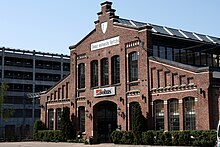Thunes mekaniske
Coordinates: 59 ° 55 ' N , 10 ° 41' E
Thunes mekaniske verksted was a Norwegian industrial company in Oslo that manufactured locomotives , among other things .
history
The company has its roots in the forge, which was founded by Anders Paulsen Thune in Drammen in 1815 .
His son Halvor Thune took over the company and moved to Christiania in 1851. In 1870 the workshops were in Ruseløkkveien. In 1871, Andreas Lauritz Thune , the founder's grandson, took over the company. The production was considerably expanded and modernized under his leadership. Andreas Thune moved the workshops to Munkedamsveien (at the Westbahnhof ). There he began with the production of combine harvesters and later steam engines and locomotives.
Eventually the premises in Munkedamsveien became too small for large-scale industrial production. Because this was in the center of the city it was difficult to expand. Instead, Thune bought property in Skøyen in Aker , then a rural community outside Christiania. In addition, Skøyen had a train station . Thune moved to Skøyen in 1901 and all manufacturing activities on Munkedamsveien were discontinued in 1903. In Skøyen, the workshop began producing turbines and locomotives.
Thune had around six hundred workers in the 1950s. In 1969 the company merged with Eureka Mekaniske Værksted to form Thune-Eureka . The manufacturing facilities were relocated to Tranby in 1976 . The name Thune disappeared completely when Thune-Eureka was bought by Kværner , which was renamed Kvaerner Eureka . The old production halls house offices, restaurants and shops. The area is still known locally as Thune .
Thune is founded
The name Thune reappeared in Hamar in the 1990s when Thune maskine in Hamar was again bought out of the Kvaerner Group. Today the company is active in mechanical production for industrial and offshore products. Thune also trades in products for equipping hospitals . Thune Produkter AS had 40 employees in 2013.
Locomotive production
Between 1901 and 1920 Thune and Hamar Jernstøberi supplied around 250 locomotives to the State Railways , including steam locomotives of the types NSB Type 21 , NSB Type 22 , NSB Type 23 , NSB Type 24 , NSB Type 25 , NSB Type 26 , NSB Type 27 , NSB Type 30 , NSB Type 31 , NSB Type 33 , NSB Type 40 and NSB Type 45 .
From 1920 both plants worked together as Norsk Maskin Industri . This consortium became the main supplier of locomotives for the Norwegian railway companies.
The highlight of steam locomotive production was the so-called Dovregubbene ( NSB Type 49 ), which were built together with Hamar Jernstøberi . Thune and Hamar supplied five of these locomotives between 1935 and 1941. Because of the Second World War , the production of the Type 49 was discontinued, four locomotives under construction were not completed.
Thune also built the mechanical part of a number of NSB electric locomotive types: NSB El 1 , NSB El 2 , NSB El 3 , NSB El 4 , NSB El 5 , NSB El 8 , NSB El 9 , NSB El 11 , NSB El 13 , NSB El 14 , NSB El 15 and NSB El 16 . Thune built 48 of the NSB Di 2 diesel locomotive .
literature
- Håkon Gundersen: Samferdsel i Norge . In: Samlaget . Oslo 1983, ISBN 82-521-2362-7 , pp. 75 .
Individual evidence
- ^ Thune Produkter AS. In: thuneprodukter.no. Retrieved May 18, 2019 (Norwegian).
Web links
- Branntakster forteller industrial history. Oslo Kommune, Byarkivet, accessed November 24, 2013 .
- Trond Smith-Meyer: Andreas Lauritz Thune. In: Store Norske Leksikon. Retrieved November 24, 2013 .
- Rolf Bryhn: Kværner ASA. In: Store Norske Leksikon. Retrieved November 24, 2013 .

